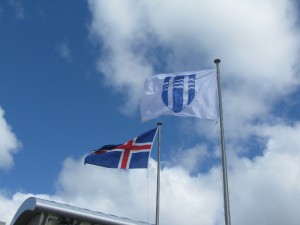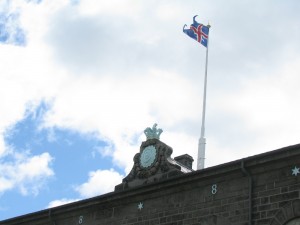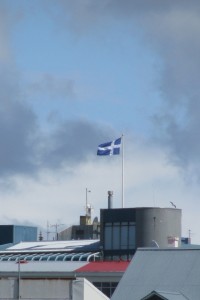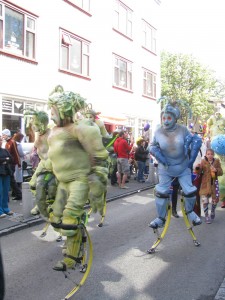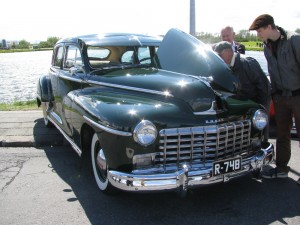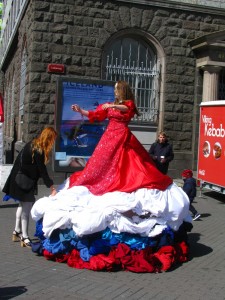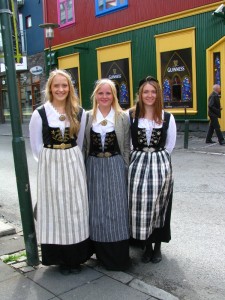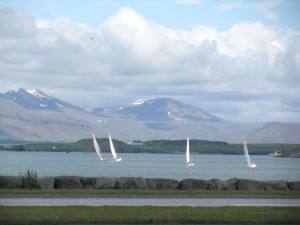Happy Birthday, Iceland! Posted by hulda on Jun 17, 2012 in Icelandic culture, Icelandic customs, Icelandic history
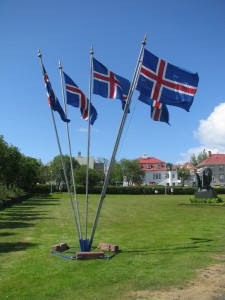 “Hæ, hó, jibbí, jei og jibbí, jei – Það er kominn 17. júní!” In other words, happy Independence Day Iceland and Icelanders!
“Hæ, hó, jibbí, jei og jibbí, jei – Það er kominn 17. júní!” In other words, happy Independence Day Iceland and Icelanders!
Today’s a big fest downtown that began in the morning and will go on until at least seven p.m. We have been lucky with the weather today, it’s been sunny and warm with only a little bit of wind. Downtown was packed with people as you can imagine, there were flags everywhere no matter which way I turned my head and booths selling candy, balloons and other related goods. Everybody seemed to be in the best of moods, cafes had added extra tables outside clearly anticipating a busier than normal day (which it indeed was) and I got to try out my language skills with photo requests. 😀
No one knows who found Iceland first, but the most popular theory seems to be Irish monks who possibly lived on the island now known as Papey, named after a group of monks called “Papar”. People from the Scandinavian area settled in in the 9th century and until 1262 Iceland was a commonwealth. Long civil wars weakened the country, though, and it eventually sought help from Norway, forming a union with it under the Norwegian crown. When the Scandinavian countries allied in Kalmar Union, Iceland moved under the Danish rule and stayed until after a long struggle for independence they finally received it in 1944. In the opinion of Icelanders, independence is the key term for defining them as a nation and a folk, and therefore the Independence/National Day is celebrated with gusto.
The colours of the flag represent fire, snow and distant mountains. “Fjarlægðin gerir fjöllin blá og mennina mikla” (“Distance makes mountains seem more blue and men seem more mighty”) goes an old Icelandic proverb and true enough, the further a mountain is the bluer it looks.
The state flag on top of the House of the Parliament. There’s also an interesting detail right next to it: the Danish crown and the initials of Christian IX of Denmark, who reigned when this house was originally built in 1881. It was debated at the time Iceland became independent that the crown and initials ought perhaps to be removed, but eventually they were left as they were.
Nope – there’s no mistake in this flag and it, too, is considered one type of a flag of Iceland! During the independence struggle Hvítbláinn, the White-Blue, was suggested as a flag for Iceland and received much popularity but wasn’t eventually chosen. It’s flown on top of this building every year this day because once upon a time when Iceland still belonged to Denmark, a young man climbed on top of this house and swapped the Dannebrog, the Danish flag, with it. A political scandal naturally ensued, which Icelanders still proudly remember.
But what about today, then? Let’s have a look at some of the things that went on downtown.
The first clip of the video is of the annual parade. It features marching bands, people in costumes, lots and lots of balloons as well as anyone who wants to join it. The parade begins near Hlemmur (= lid?) and moves down Laugarvegur (= bath/hot spring road) all the way to Ingólfstorg (= Ingólfur’s square) where it gradually dissolves. It’s like an opening to the whole celebration although in theory the fest always begins some hours earlier, but at least to me it seemed like more people suddenly poured in at the time of the parade. An hour before it we found a parking spot easily; after the parade there were cars parked in the most amazingly illegal ways everywhere because there simply was no space anymore.
Monsters at the parade.
There’s also an annual old car “exhibition”, a meeting for people who want to show off their cars. Naturally I went to investigate. They had closed off a whole bridge for it and parked the cars there side by side. Last year the place was the same so perhaps that’s where the meeting is regularly held.
This being Iceland, any reason for street art is a good reason. Be prepared to see numerous performances if you happen to be here around this time.
“Lost children”. 😀
Of course there’ll also be many people wearing íslenskir þjóðbúningar, Icelandic national dresses. There are a few types of national dress, of which the above one called upphlutur tends to be the most common. The outfits vary greatly and for example the aprons can be made of nearly any fabric since they don’t have to be as uniform as national dresses tend to be elsewhere in Europe.

Build vocabulary, practice pronunciation, and more with Transparent Language Online. Available anytime, anywhere, on any device.
About the Author: hulda
Hi, I'm Hulda, originally Finnish but now living in the suburbs of Reykjavík. I'm here to help you in any way I can if you're considering learning Icelandic. Nice to meet you!



